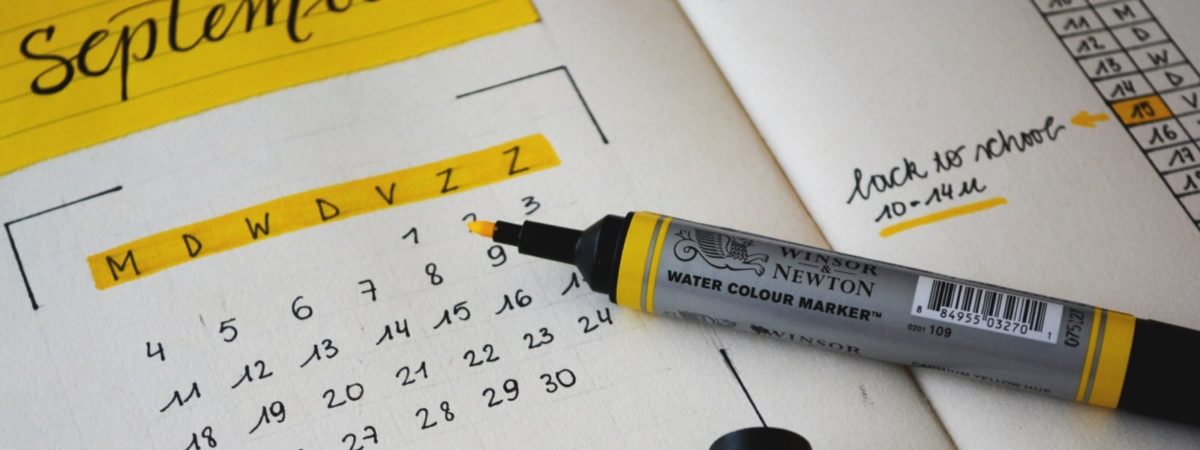Do you find it hard to stay consistent with your goals—rushing into them headfirst with a burst of initial enthusiasm, only to “fall off the wagon” and give up on them eventually?
- Maybe you tend to sign up for new gym memberships but stop going after the first couple months.
- Maybe you start a blog, write a few posts, then abandon it as life gets busier and more hectic.
- Or maybe you’ve tried to stick to a new diet regimen, lost some serious weight after a few months, but then find yourself backsliding in the long run.
Whatever your particular goals are, the real challenge is to stay consistent with them day in and day out, month after month, and even, year after year.
And while there are countless tips and techniques out there for how to stay consistent with your goals and build new habits, there’s one that I’ve found to be both highly effective and remarkably simple.
It’s called the Seinfeld Strategy.
What is the Seinfeld Strategy, exactly?
The Seinfeld Strategy is a simple but powerful technique for sticking to habits and following through on goals. It was popularized by a Lifehacker article called Jerry Seinfeld’s Productivity Secret.
The article recounts how a young software developer named Brad Isaac happened to get the chance to ask the comedian Jerry Seinfeld for some advice about “making it” with his work.
Seinfeld reportedly told him that the secret was consistency. Specifically, Seinfeld thought that the key to producing good work was to write something (for his comedy act) every single day.
The trouble is, staying consistent with something like that is hard—sometimes we feel lazy and unmotivated, sometimes life happens and we get interrupted, sometimes we get afraid, worried that what we’re doing isn’t really worthwhile or what others will think.
In any case, Seinfeld realized he needed more than good intentions to write consistently and produce great work. He needed a system. Something to keep him accountable and motivated to write daily—even when it was hard.
Here’s how Issac’s describes Jerry Seinfeld telling him about his Seinfeld Strategy:
He told me to get a big wall calendar that has a whole year on one page and hang it on a prominent wall. The next step was to get a big red magic marker.
He said for each day that I do my task of writing, I get to put a big red X over that day. “After a few days you’ll have a chain. Just keep at it and the chain will grow longer every day. You’ll like seeing that chain, especially when you get a few weeks under your belt. Your only job next is to not break the chain.”
“Don’t break the chain,” he said again for emphasis.
The Seinfeld Strategy boils down to one big idea:
If you want to build a habit that sticks and reach your goal, you must track your progress in a simple, concrete way.
Baked into this seemingly simple method for staying consistent with our goals there’s actually a number of very clever elements that make it so effective. But before we get there, let’s talk about how to actually use the Seinfeld Strategy.
A step-by-step guide to using the Seinfeld Strategy for your own goals and habits
In my work as a psychologist, I’ve helped hundreds of clients build a huge variety of new habits and reach all sorts of difficult goals using the Seinfeld Strategy.
From establishing a daily meditation habit to better eating habits and starting new businesses, you can easily adapt the Seinfeld Strategy to whatever your specific needs and goals are.
Here’s my step-by-step instructions for getting started with the Seinfeld Strategy:
- Decide on your goal. Your goal is the outcome you want to achieve. For example: lose 20 pounds, write my novel, don’t eat after 7:00 PM, build a better relationship with my kids. The more specific and concrete your goal, the better.
- Break your goal down into routines. Routines are small actions which, if performed consistently, will lead to the completion of your goal. For example, if your goal is to lose 20 pounds, one routine that will help you there might be don’t eat after 7:00 PM or walk 20 minutes per day. Again, try to make your routine as specific and concrete as possible. Routines should also be verbs not nouns: write for 20 minutes, not writing. If possible, try to create routines that are small enough to be performed on a daily basis. The reason is, the more motivation you can build the more likely you will be to succeed, and each time you successfully complete your routine, you’ll get some motivation. Getting a hit of motivation every day is better than twice a week.
- Set up your calendar. Seinfeld recommended a big wall calendar but really any physical calendar or tracker will do. Crucially, make sure the calendar “lives” as close to the place you perform the routine as possible. If your routine involves writing, put the calendar by your desk. If your routine involves eating, put your calendar on your fridge. The idea is you want the calendar to be visually obvious so that your goal and routine is always present in mind and holding you accountable. Also, as you progress, it will serve as a motivating force—walking by your fridge and seeing a streak of 15 checkmarks in a row will be hugely motivating!
- Mark your successes exuberantly. This one’s gonna sound dumb, but I think it matters a lot, actually: Try to be as exuberant, playful, and fun with your success marks as possible. Use your favorite color marker, incorporate stickers, fill in the day with an elaborate design rather than a simple X, whatever you come up with. The more visually appealing and distinctive your progress mark is, the more rewarding it will be—both at the time of completion and each time you see it. And the more rewarding it is, the more motivation it will give you.
- Don’t miss twice. When you inevitably miss a routine, be compassionate with yourself. Reframe it away from terms like failed, screwed up, and blew it with gentler (and more realistic) terms like missed or slipped up. Overly harsh, judgmental self-talk around misses will only sap you of motivation and make future misses more likely. Instead, acknowledge that it’s normal to miss sometimes and that the most important thing is to re-commit to getting it done next time. As James Clear likes to say, Never miss twice. This is a great little mantra or rule for yourself because it implies that it’s okay to miss once, which makes it more likely that you won’t miss next time.
Those should be enough to get you started with whatever goal or habit you’d like to be more consistent with.
Got an especially tricky situation that you’re not sure how to use the Seinfeld Strategy for? I’d love to hear about it and maybe offer some tips in the comments at the end of the article!
Why the Seinfeld Strategy Works
The Seinfeld Strategy is the best technique for most people to build better habits and stick with their goals because it combines simplicity with power.
Specifically, here are 5 reasons I think the Seinfeld Strategy is so useful:
- Accountability. Something about the ugliness of a missed square in my calendar is strangely motivating. Behaviorally, this is the proverbial “stick” aspect of The Seinfeld Strategy’s motivational power. It makes your misses obvious and painful, and therefore, incentivizes you to avoid them.
- Reward. In addition to “The Stick,” The Seinfeld Strategy also includes “The Carrot.” For some reason, filling in my little squares is strangely satisfying and rewarding. Plus, each time I see my calendar I see how many squares and days in a row I’ve done my goal. This gives me another hit of positive reinforcement and self-satisfaction, which in turn means more motivation for next time.
- Memory Enhancement. One of the powers of The Seinfeld Strategy is that it doesn’t let you forget about your habit or goal. It’s a real physical thing that sits right there on your desk, wall, or wherever it is that you do your work. Its physicality makes it unmissable.
- Easy of Use. The elegance and simplicity of The Seinfeld Strategy appeal to me over more complicated and feature-packed commitment devices and habit tracking systems. But in addition to being appealing, the simple nature of it makes it very low-friction and easy to just do compared to more complicated systems.
- Physicality. As our lives become increasingly digitized, it’s powerfully refreshing to re-introduce more analog objects and processes back into our lives and daily routines. Putting pen to paper and filling a square up with real ink feels far more satisfying and grounding than clicking yet another virtual button or check-box.
Watch out for these 3 common mistakes with the Seinfeld Strategy
The Seinfeld Strategy is a simple, powerful method for sticking with your goals and building new habits. It’s also flexible and can be adapted to almost any particular goal or habit you’re working on. But there are a few important constraints you should be aware of.
- A Wandering Calendar. You must keep your calendar or notebook physically present wherever you work or complete your habit, preferably within eye-sight. Also, don’t attach it to or bundle it together with something else like your regular planner or notebook. It should be its own dedicated thing with its own dedicated place.
- Going Digital. It’s tempting to try and take The Seinfeld Strategy digital along with the rest of our lives, but you must resist. Trust me, I’ve tried using apps and notes on my phone for this. It’s no good. The physicality of a calendar or notebook plus a pen or pencil is a vital part of the process.
- Poor Timing. Be thoughtful about the time of day you set to do your routine. If you’re not sure about the best time, do a series of one-week experiments to test out which time seems to work best for you.
All You Need to Know
To wrap up, here are the most important points we covered:
- The Seinfeld Strategy is a simple, powerful, and flexible technique for staying consistent with our goals and building new habits. It simply involves tracking your regular progress with a simple calendar.
- The Seinfeld Strategy is effective because it provides accountability, positive reinforcement, memory enhancement, easy of use, and physicality.
- 3 potential pitfalls to watch out for when using the Seinfeld Strategy are: 1) trying to make your calendar part of another item or project, 2) using a digital calendar or app, and 3) scheduling your routine at the wrong time.





16 Comments
Add YoursThank you for sharing – I believe this can work. Any thoughts on what to do when traveling?
You can do the same thing with a small journal—it doesn’t HAVE to be a wall calendar necessarily. Just draw out a little calendar in a pocket notebook!
Great idea! Thank you!
A great article Nick, I sometimes set goals that are too big, so starting with small ones and working on them regularly is important. They can feel like ‘not much’, but if I have missed a few days and give up on the small goals, then I am down on myself and it isn’t easy to then aim for bigger goals. I too like James Clear and am trying to write three pages each morning before my kids get up. Two pages of writing about anything on my mind and one on my intentions for the day. It helps to clear my thoughts and I have identified different thoughts, emotions and ideas that may not have come up if I hadn’t been writing.
Another is to set aside 15 minutes for creativity, but I haven’t achieved this yet, so I might add it onto my writing time and begin with just 5 minutes. Consistency and regular routine are crucial. Next I need to get a calendar for those X’s!!!!! Thank you.
Thanks, Jodi! This technique single-handedly kickstarted my writing two years ago—it’s the best! Good luck 🙂
Hi Nick, Thank you for such a great, useful, and practicable article. (Minor typo in 3 Set up your calendar: If your routine involves eating, but your calendar on your fridge.)
Your crystal clear explanation and tips really encourage one to put it into action right away.
Thanks again,
Alan
Thanks for the typo catch! cheers, Nick
Hello Nick,
I liked the article and want to start using this method soon enough. Now, what if I have many habits to build ? Do I make a calendar for each ?
Thank you ?
Great question! One way around this I’ve seen is to divide each day into four small boxes and use different colors to fill in each.
Another eyeopener from you, Nick. It is always very helpful.
I guess you mean one would need more than one calendar in case he set more than one goal.???
Thank you so much
Not necessarily… See comment above ?
ok, thank you
Great information! I challenged myself two things the month of September: 1. To do 100 sit ups and squats a day and 2. Don’t eat meat. I have tracked my progress on our family calendar with star stickers. I had no idea that there was a well known strategy behind this, besides my elementary school desires to seek positive reinforcement (in form of stickers). It does make an impact on my motivation to see the continuous application of stickers on the calendar. Now, just to get more stickers for the rest of my goals which (coincidentally?) have not been going as well . . .
ALL the stickers 🙂
I used this technique 35 years ago to quit smoking. I took a piece of graph paper and every hour that I didn’t smoke I filled in a square with a red pen. As the completed squares grew it was easier to go just one more hour. I could do one hour. It took 169 squares to reach a place where I didn’t need it and had quit.
Hi Nick,
I’m enjoying your newsletters and site, as well as this article. You give the ‘don’t break the chain method’ a lot more dimension than most others.
But… sorry to rain on your parade… imho you’ve got the quote wrong. I recently pointed this out to another blogger/writer and I’ve also posted the following comment on Lifehacker (not approved yet, I doubt they ever will):
—
The reference to Jerry Seinfeld’s “X calendar trick” is all over the internet (and seems to have been started by a ‘comedian’ at Lifehacker). But he also seems to have claimed that he did not actually say it (either to a reporter or a colleague stand-up comedian).
See https://www.reddit.com/r/IAmA/comments/1ujvrg/jerry_seinfeld_here_i_will_give_you_an_answer/ceitfxh/
6 years ago
Jerry: This is hilarious to me, that somehow I am getting credit for making an X on a calendar with the Seinfeld productivity program. It’s the dumbest non-idea that was not mine, but somehow I’m getting credit for it.
Probably Lifehacker.com started this. Apparently a reference to a famous person was used to spice up a headline: In 2007, Brad Isaac, an aspiring comedian and productivity blogger wrote an article for Lifehacker about getting advice from Jerry Seinfeld on creating more content for his act. But was that a fake report!?
—
Misquotes happen more often. See https://quoteinvestigator.com although that source didn’t have the Seinfeld X quote.
Take care & keep ‘m coming.
Hans